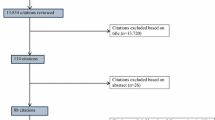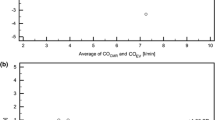Abstract
Echocardiographic measurement of cardiac output with automated software analyses of spectral curves in the left ventricular outflow tract has been introduced. This study aimed to assess the precision and accuracy of cardiac output measurements as well as the ability to track cardiac output changes over time comparing the automated echocardiographic method with the continuous pulmonary artery thermodilution cardiac output technique and the manual echocardiographic method in cardiac surgery patients. Cardiac output was measured simultaneously with all three methods in 50 patients on the morning after cardiac surgery. A second comparison was performed 90–180 min later. Precisions for each method were measured. Bias and limits of agreement (LoA) between methods were assessed and concordance- and polar plots were used for evaluating trending of cardiac output. When comparing the automated echocardiographic method with the thermodilution technique, the mean bias was 0.72 L/min with LoA − 1.89; 3.33 L/min corresponding to a percentage error of 46%. The concordance rate was 47%. The mean bias between the automated- and the manual echocardiographic methods was − 0.06 L/min (95% LoA − 2.33; 2.21 L/min, percentage error 42%). The concordance rate was 79%. The automated echocardiographic method did not meet the criteria for interchangeability with the thermodilution technique or the manual echocardiographic method. Trending ability was poor when compared to the continuous thermodilution technique, but moderate when compared to the manual echocardiographic method.
Trial registry number: NCT03372863. Retrospectively registered December 14th 2017.




Similar content being viewed by others
Abbreviations
- CCO:
-
Continuous cardiac output
- CI:
-
Confidence interval
- CO:
-
Cardiac output
- CV:
-
Coefficient of variation
- LoA:
-
Limits of agreement
- LVOT:
-
Left ventricular outflow tract
- PAC:
-
Pulmonary artery catheter
- ROI:
-
Region of interest
- VTI:
-
Velocity time integral
References
Monnet X, Teboul J-L. Cardiac output monitoring: throw it out… or keep it? Crit Care. 2018;22:35.
Cecconi M, De Backer D, Antonelli M, Beale R, Bakker J, Hofer C, et al. Consensus on circulatory shock and hemodynamic monitoring. Task force of the European Society of Intensive Care Medicine. Intensive Care Med. 2014;40:1795–815.
Monnet X, Teboul J-L. Transpulmonary thermodilution: advantages and limits. Crit Care. 2017;21:147.
Ganz W, Donoso R, Marcus HS, Forrester JS, Swan HJ. A new technique for measurement of cardiac output by thermodilution in man. Am J Cardiol. 1971;27:392–6.
Marik PE. Obituary: pulmonary artery catheter 1970 to 2013. Ann Intensive Care. 2013;3:38.
Rajaram SS, Desai NK, Kalra A, Gajera M, Cavanaugh SK, Brampton W, et al. Pulmonary artery catheters for adult patients in intensive care. Cochrane Database Syst Rev. 2013;2:CD003408.
Hadian M, Pinsky MR. Evidence-based review of the use of the pulmonary artery catheter: impact data and complications. Crit Care. 2006;10:S8.
Aranda M, Mihm FG, Garrett S, Mihm MN, Pearl RG. Continuous cardiac output catheters: delay in in vitro response time after controlled flow changes. Anesthesiology. 1998;89:1592–5.
Dubin J, Wallerson DC, Cody RJ, Devereux RB. Comparative accuracy of Doppler echocardiographic methods for clinical stroke volume determination. Am Heart J. 1990;120:116–23.
Harris PA, Taylor R, Thielke R, Payne J, Gonzalez N, Conde JG. Research electronic data capture (REDCap): a metadata-driven methodology and workflow process for providing translational research informatics support. J Biomed Inform. 2009;42:377–81.
US Patent 10206651B2. Found at https://patentswarm.com/patents/US10206651B2.
Baumgartner H, Hung J, Bermejo J, Chambers JB, Edvardsen T, Goldstein S, et al. Recommendations on the echocardiographic assessment of aortic valve stenosis: a focused update from the European Association of Cardiovascular Imaging and the American Society of Echocardiography. J Am Soc Echocardiogr. 2017;30:372–92.
Mercado P, Maizel J, Beyls C, Titeca-Beauport D, Joris M, Kontar L, et al. Transthoracic echocardiography: an accurate and precise method for estimating cardiac output in the critically ill patient. Crit Care. 2017;21:136.
Critchley LA, Critchley JA. A meta-analysis of studies using bias and precision statistics to compare cardiac output measurement techniques. J Clin Monit Comput. 1999;15:85–91.
Martin Bland J, Altman D. Statistical methods for assessing agreement between two methods of clinical measurement. Lancet. 1986;327:307–10.
Bakdash JZ, Marusich LR. Repeated measures correlation. Front Psychol. 2017;8:456.
Montenij LJ, Buhre WF, Jansen JR, Kruitwagen CL, De Waal EE. Methodology of method comparison studies evaluating the validity of cardiac output monitors: a stepwise approach and checklist. Br J Anaesth. 2016;116:750–8.
Cecconi M, Rhodes A, Poloniecki J, Della Rocca G, Grounds RM. Bench-to-bedside review: the importance of the precision of the reference technique in method comparison studies—with specific reference to the measurement of cardiac output. Crit Care. 2009;13:201.
Critchley LA, Yang XX, Lee A. Assessment of trending ability of cardiac output monitors by polar plot methodology. J Cardiothorac Vasc Anesth. 2011;25:536–46.
Saugel B, Grothe O, Wagner JY. Tracking changes in cardiac output: statistical considerations on the 4-quadrant plot and the polar plot methodology. Anesth Analg. 2015;121:514–24.
Cornette J, Laker S, Jeffery B, Lombaard H, Alberts A, Rizopoulos D, et al. Validation of maternal cardiac output assessed by transthoracic echocardiography against pulmonary artery catheterization in severely ill pregnant women: prospective comparative study and systematic review. Ultrasound Obstet Gynecol. 2017;49:25–31.
McLean AS, Needham A, Stewart D, Parkin R. Estimation of cardiac output by noninvasive echocardiographic techniques in the critically ill subject. Anaesth Intensive Care. 1997;25:250–4.
Mayer SA, Sherman D, Fink ME, Homma S, Solomon RA, Lennihan L, et al. Noninvasive monitoring of cardiac output by Doppler echocardiography in patients treated with volume expansion after subarachnoid hemorrhage. Crit Care Med. 1995;23:1470–4.
Temporelli PL, Scapellato F, Eleuteri E, Imparato A, Giannuzzi P. Doppler echocardiography in advanced systolic heart failure: a noninvasive alternative to Swan-Ganz catheter. Circ Hear Fail. 2010;3:387–94.
Tian Z, Liu Y-T, Fang Q, Ni C, Chen T-B, Fang L-G, et al. Hemodynamic parameters obtained by transthoracic echocardiography and right heart catheterization: a comparative study in patients with pulmonary hypertension. Chin Med J (Engl). 2011;124:1796–801.
Kou S, Caballero L, Dulgheru R, Voilliot D, De Sousa C, Kacharava G, et al. Echocardiographic reference ranges for normal cardiac chamber size: results from the NORRE study. Eur Hear J. 2014;15:680–90.
Frederiksen CA, Juhl-Olsen P, Hermansen JF, Andersen NH, Sloth E. Clinical utility of semi-automated estimation of ejection fraction at the point-of-care. Hear Lung Vessel. 2015;7:208–16.
Schmid ER, Schmidlin D, Tornic M, Seifert B. Continuous thermodilution cardiac output: clinical validation against a reference technique of known accuracy. Intensive Care Med. 1999;25:166–72.
Jakobsen CJ, Melsen NC, Andresen EB. Continuous cardiac output measurements in the perioperative period. Acta Anaesthesiol Scand. 1995;39:485–8.
Della Rocca G, Costa MG, Pompei L, Coccia C, Pietropaoli P. Continuous and intermittent cardiac output measurement: pulmonary artery catheter versus aortic transpulmonary technique. Br J Anaesth. 2002;88:350–6.
Rödig G, Keyl C, Liebold A, Hobbhahn J. Intra-operative evaluation of a continuous versus intermittent bolus thermodilution technique of cardiac output measurement in cardiac surgical patients. Eur J Anaesthesiol. 1998;15:196–201.
Acknowledgements
The authors wish to thank the staff at the postoperative intensive care unit, Aarhus University Hospital, for their invaluable assistance in patient inclusion and execution of the protocol. Likewise, the authors thank GE Healthcare for making available a Venue R1 ultrasound system for the study.
Funding
None.
Author information
Authors and Affiliations
Corresponding author
Ethics declarations
Conflict of interests
Peter Juhl-Olsen has received minor funds from GE Healthcare and Novartis for teaching courses on critical care. GE Healthcare provided the Venue R1 ultrasound system free of charge for the study without influence on study design, study execution, data interpretation or any aspect of the manuscript writing. All other authors declare that they have not conflict of interests.
Additional information
Publisher's Note
Springer Nature remains neutral with regard to jurisdictional claims in published maps and institutional affiliations.
Electronic supplementary material
Below is the link to the electronic supplementary material.
10877_2019_413_MOESM1_ESM.tiff
Polar plots for comparison of the automated software echocardiographic method (automated CO), the manual echocardiographic method (manual CO) and continuous cardiac output (CCO) for measuring cardiac output (CO). Individual comparisons are given and both standard and modified polar plots are presented. Standard polar plots include data outside a 10% central exclusion zone of the polar plots as proposed [19]. Modified polar plots reuses the 15% central exclusion zone of the four-quadrant plots. Biases (red lines) and limits of agreement (black lines) for the polar lot are given in the manuscript. The first scan was performed on the morning after surgery. The second scan was performed one to 3 h later following routine physiotherapy and mobilisation. Supplementary material 1 (TIFF 699 kb)
Rights and permissions
About this article
Cite this article
Juhl-Olsen, P., Smith, S.H., Grejs, A.M. et al. Automated echocardiography for measuring and tracking cardiac output after cardiac surgery: a validation study. J Clin Monit Comput 34, 913–922 (2020). https://doi.org/10.1007/s10877-019-00413-w
Received:
Accepted:
Published:
Issue Date:
DOI: https://doi.org/10.1007/s10877-019-00413-w




